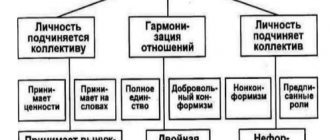Social and psychological characteristics of the group.
A group is understood as a real existing entity in which people are brought together, united by some common characteristic, a type of joint activity, or placed in some identical conditions, and in a certain way are aware of their belonging to this entity.
Psychological characteristics of the group.
The composition (composition) of a group is a set of characteristics of group members that are important from the point of view of analyzing it as a whole. The composition of a group can be described in different ways depending on whether, for example, the age, professional or social characteristics of the group members are significant in each particular case.
The structure of a group is determined by the functions performed by individual members of the group, as well as by the interpersonal relationships within it. There are several types of group structure: preference structure, “power” structure, communication structure.
Group processes include psychological and organizational processes of cohesion (leadership and management), development of the group as a social unit, group pressure, change in attitudes, etc.
Group norms are certain rules that are developed by a group, accepted by it, and to which the behavior of its members must obey in order for their joint activities to be possible. Norms thus perform a regulatory function in relation to this activity.
The values of each group are formed on the basis of developing a certain attitude towards social phenomena, dictated by the place of this group in the system of social relations, its experience in organizing certain activities.
In order to ensure that group members comply with group norms, there are group sanctions. Group sanctions are a system of rewards and punishments for group members by the group as a whole. People often talk about negative group sanctions (rejection, boycott), but it should be considered legitimate to include positive sanctions (respect, encouragement, recognition) in the system of sanctions.
Classification of groups.
First of all, for psychology it is important to divide groups into conditional and real .
Among real groups there are
real laboratory groups and real natural groups
.
In turn, natural groups are divided into large and small .
Large groups are also divided into large spontaneous groups and organized, long-existing ones. Small groups can be of two varieties: emerging groups and groups of a higher level of development, already established.
Small groups.
A small group is a small group whose members are united by common social activities and are in direct personal communication, which is the basis for the emergence of emotional relationships, group norms and group processes. The definition captures a specific feature of a small group that distinguishes it from large groups: social relations appear here in the form of direct personal contacts.
It may be noted that the dyad
.
However, there is another point of view, which believes that the smallest number of members of a small group is not two, but three people
. This is argued by the fact that in a dyad it is impossible to isolate the type of communication that is mediated by joint activity; any communication here takes on the character of an interpersonal one. The presence of a third person in the group changes the system of relationships and introduces activity into the communication process.
The upper limit of the small group is also not clearly defined. If the small group being studied must be, first of all, a really existing group and it is considered as a subject of activity, then it is logical not to set some kind of hard “upper” limit, but to take as such the really existing, given size of the group, dictated by the purpose of joint group activity .
Types of small groups.
Small groups are divided into primary and secondary. The primary to those groups in which direct contacts are made between its members. Secondary are those where there are no direct contacts, and various “intermediaries” are used for communication between members, for example, in the form of means of communication. But when such a feature was identified, primary groups began to be identified with small groups, and then the classification lost its meaning.
Another division of small groups involves dividing small groups into formal and informal. In a formal group, all the positions of its members are clearly defined, they are prescribed by group norms, and the roles of all group members are strictly distributed in the system of subordination to the so-called power structure. Informal groups take shape and arise spontaneously, where neither statuses nor roles are prescribed, where there is no given system of vertical relationships. An informal group can be created within a formal one, but it can also arise on its own, outside of it.
In reality, it is difficult to distinguish strictly formal and strictly informal groups, especially in cases where informal groups arose within the framework of formal ones. Therefore, in social psychology, proposals were born that remove this dichotomy. The concepts of “formal” and “informal structure” of a group (or “structure of formal and informal relations”) were introduced, and it was not the groups that began to differ, but the type and nature of the relationships within them.
The third classification distinguishes membership groups and reference groups. Membership groups are considered to be those groups in which the individual is actually included; In contrast, reference groups are groups in which individuals are not really included, but they accept their norms. Subsequently, two functions of reference groups were identified: comparative and normative; An individual needs a reference group either as a standard for comparing his behavior with it, or for normative assessment of it.
Based on the duration of their existence, small groups are divided into temporary and stationary.
According to the level of development, groups are divided into:
A team is a voluntary association of people, characterized by a high level of mediation of interpersonal relationships by joint activities and the presence of socially approved goals (for example, a work team that has reached socio-psychological maturity).
A corporation is a group that has reached a high level of socio-psychological maturity, but pursues socially disapproved goals (a highly organized criminal group).
Prosocial association is characterized by a low degree of mediation of interpersonal relationships by joint activities and the social nature of the goals (for example, a newly created study group).
An antisocial association is characterized by the antisocial nature of the activity and a low degree of mediation of interpersonal relationships by this activity.
A diffuse group is a collection of people who are united only by place and time, and there is practically no joint activity (bus passengers).
Social and psychological characteristics of the group.
These include the presence of a certain small group structure, behavior associated with the implementation of group norms, and group cohesion.
It has already been noted that in a small group different types of structures depending on the selected criterion. The formal status structure gives an idea of the relationship of positions in the formal structure of the group. For work collectives, it coincides with the staffing table.
The structure of preferences is expressed in the sociometric statuses of group members. It is often seen as analogous to the informal status structure of a group.
The communicative structure characterizes the intragroup positions of individuals depending on information flows in the group. Features of the communicative structure influence the organizational development of the group and its activities. As a rule, a centralized structure, compared to a decentralized structure, promotes the emergence of a leader and organizational development, but impedes the effectiveness of solving complex problems and reduces satisfaction with group membership.
Power structure is the vertical relative arrangement of individuals depending on their ability to exert influence in a group. In total, five types of social power can be distinguished: 1) rewarding; 2) coercive; 3) legitimate; 4) reference; 5) expert.
Therefore, it is possible to construct different group power structures depending on the type of power being considered. Real group management is usually carried out simultaneously through different channels.
Another significant characteristic of an established group is behavior associated with the implementation of group norms. Quite roughly, three areas can be distinguished: 1) the influence of norms shared by the majority of group members; 2) the influence of norms shared by a minority of group members; 3) deviations of individual behavior from group norms. The first area is associated with manifestations of conformist behavior
, the second - with
the influence of a minority
, the third - with the phenomenon
of group pressure
.
The concept of “conformity” refers to a change in behavior or attitudes as a result of real or imagined influence from a group.
The influence of the minority comes down to the following: the functioning of the group is possible on the basis of agreement on some fundamental principles. A minority may try to change these principles by undermining the consensus. In order to influence the majority, the minority must be consistent and demonstrate self-confidence. The position of the minority is sharply strengthened by the presence of “apostates” on the part of the majority. In addition, unusual position and behavior have an attractive force for others, which can also influence the majority.
Group pressure is the actions of a group to force a group member to behave in accordance with norms. Group pressure can be implemented in various ways: through condemnation, lowering group status, boycott, even expulsion from the group. It performs several important functions in the life of the group: 1) goal-setting - ensures the achievement of the goal; 2) preservative – preserves the group as a whole; 3) constructive – contributes to the development of “group reality”; 4) relational - participates in determining the attitude of group members to the social environment.
The third characteristic of an established group is group cohesion
.
Group cohesion is the sum of all the forces operating in a group that force a person to maintain his membership in the group and experience positive emotions from being a member of it.
Cohesion characterizes the degree to which a group is attractive to its members. A cohesive group is characterized by unity of goals, values, cooperation, a friendly atmosphere, genuine interest of group members in each other and a desire to help. The presence of a common goal in a group, the coincidence of individual and group goals, interpersonal sympathy, the presence of danger external to the group, threats and a number of other factors contribute to the growth of group cohesion. The socio - psychological climate is an integral characteristic of the group. The socio-psychological climate of a group is a stable mental state of a group, reflecting the characteristics of its life activity. This is a set of conditions that promote or hinder productive group activity and the comprehensive development of the individual in the group. This is a qualitative characteristic of interpersonal relationships in a group, a system of relationships of group members to the conditions, nature, content of joint activities, to the leader and other members of the group.
Favorable
The socio-psychological climate is characterized by trust, goodwill in relationships, mutual understanding, free expression by group members of their opinions and respect for the opinions of others, constructive criticism, a sense of security, optimism, confidence, satisfaction from membership in the group.
An unfavorable
socio-psychological climate is characterized by tension in relationships between group members, conflict, a predominance of depressed mood, and dissatisfaction with group membership. A favorable psychological climate is a condition for the effectiveness of the group.
Factors influencing the socio-psychological climate: the nature of interpersonal relationships, the personality of the leader and the management style and methods he implements, psychological compatibility, the presence of microgroups, the nature of the interaction between them, the influence of the external social environment, as well as the physical microclimate, etc.
Psychological compatibility is the ability of group members to perform joint activities. Psychological compatibility is based on the optimal combination of psychological characteristics of the participants in interaction based on the principle of their similarity
or
complementarity
.
Group effects are ways in which people influence each other, as well as the mechanisms of group functioning through which group processes are carried out and group states are achieved.
In social psychology, there are two basic group effects: a person's reaction to the presence of other people and a sense of belonging to a group. The influence of the presence of other people on the psyche and behavior of an individual is a fundamental phenomenon of social psychology and is carried out unconsciously. This effect was first described by V. Moede, F. Allport and V. M. Bekhterev in the 20s. XX century It was the discovery of the fact that a person responds psychologically to the presence (real or imagined) of another person that formed the basis for the creation of the science of social psychology. Understanding the significance of this reaction, G. Allport gave the following definition of our science: “ Social psychology is a discipline that attempts to understand and explain how the thoughts, feelings and behavior of individuals are influenced by the actual, imagined or presumed presence of others.” Man is a social being, and his reaction to the presence of others manifests itself in the form of a fan of a wide variety of effects.
The effect of social facilitation
The discovery of this effect belongs to Norman Triplett, who in 1897 studied the influence of a competition situation on changes in the speed of cyclists. The group of subjects consisted of 40 children. Triplett found that cyclists clocked better when racing against each other rather than against a stopwatch, and concluded that the presence of others encouraged people to perform more vigorously.
Social facilitation in a broad sense is the strengthening of a person’s dominant (habitual, well-learned) reactions in the presence of others.
Social facilitation in a narrow sense is understood as increasing a person’s motivation to solve a task assigned to him in the presence of other people.
D. Myers also points out three reasons for the effect of social facilitation:
1) social arousal, that is, excitement of the nervous system due to the presence of other people, is innate and inherent in most social animals;
2) fear of social evaluation or concern about how other people evaluate us. The dominant response increases if a person thinks that he is being evaluated;
3) distracting attention from a specific task and specific activity and switching attention to others. This overloads the cognitive system and causes agitation.
Social inhibition is a weakening of a person’s motivation to solve a task assigned to him in the presence of other people.
The process of group formation: stages of development and distribution of roles
The formation of a community occurs in 3 stages:
- Formation and initial unity. Individuals get acquainted, primary recognition of each other occurs. There is a high level of emotional tension, which disappears as acquaintance deepens. Group members learn rules of behavior and form a sense of belonging. At this stage, one or more leaders are identified.
- The emergence of contradictions and conflicts. There is a conflict of interests between small unions and individualists trying to assert their place in the team. The struggle for leadership leads to contradictions, quarrels and division.
- Constructive cooperation. The level of psychological unity increases. The group acquires status in society and approaches the status of a collective. The emotional atmosphere levels out and becomes friendly.
The process of an individual’s entry into a team occurs in 3 phases:
- Adaptation. The personality learns the rules of behavior, and is still constrained in the manifestations of individual qualities.
- Personalization. The personality declares itself in order to take the most advantageous place in the hierarchy.
- Integration. The team determines the newcomer’s place by assessing his personal qualities.
The following roles are distinguished in the group according to the level of authority:
- leader;
- popular;
- preferred;
- ignored;
- outsiders.
The higher the status of an individual, the more power he enjoys. In the process of development of a team, individuals can challenge the assigned status, moving to the top level of the hierarchy. If the rules of behavior in the group are neglected, the individual who initially occupied a high position may move down.









